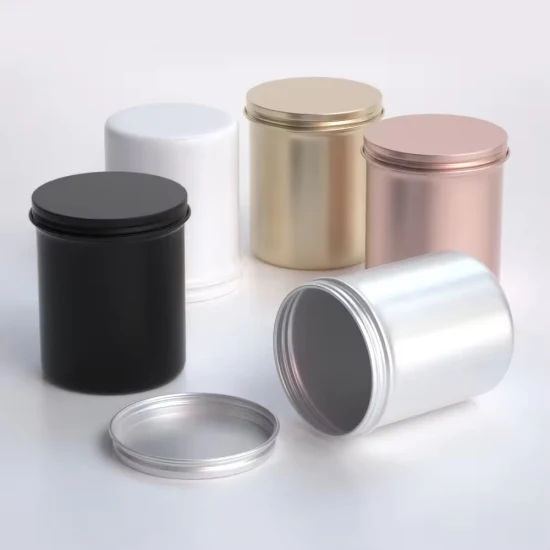Custom tin cans for cosmetics: magnetic opening and closing + mirror polishing process
To boost sales, cosmetics companies and major brands are considering how to ensure aesthetically pleasing packaging while protecting the product and attracting consumers. Customized tin cans achieve this dual purpose. This approach offers a diverse and personalized metal packaging solution that can be fully customized based on the size, shape, and surface finish of the jar. Advanced features such as magnetic closures and mirror polishing can create a high-gloss finish, enhancing the functionality and visual appeal of cosmetic packaging.
The role of magnetic opening and closing mechanism in the user experience of custom tin cans
The custom tin cans designed for the cosmetics industry feature magnetic closures that ensure a smooth and easy opening and closing experience, thereby increasing overall user satisfaction. The designers created the magnetic mechanism to provide a secure, easy-to-access closure system. Unlike traditional snap or screw caps, the magnetic system utilizes strong yet carefully calibrated magnets to secure the lid in place without requiring excessive force. This design reduces long-term wear and tear, maintaining the integrity and aesthetics of the tin. For cosmetics, the tactile feel of the packaging has a dramatic impact on perceived quality, and this mechanism has revolutionized the industry. It makes the product more user-friendly and adds an element of sophistication that aligns with a high-end brand image. Additionally, the magnetic closure design is nearly seamless, minimizing the risk of accidental opening during transport or storage.
Mirror Polishing on Custom tin cans
To create a dazzling, high-gloss surface, we use a mirror polishing process on our custom tin cans, making our customers’ cosmetic jars stand out even more. Mirror polishing not only enhances the beauty of the tin can, but also serves a practical function, with a smooth, easy-to-clean surface that retains its gloss for a long time.
The mirror polishing process involves a series of carefully controlled mechanical and chemical treatments that smooth the metal surface to a near-perfect level. The process begins with precision grinding and polishing to eliminate surface imperfections, followed by polishing stages that gradually perfect the finish. The result is a custom tin with a highly reflective surface that is eye-catching and exudes a sense of high quality. For cosmetic brands, such a finish is crucial as it enhances the feeling of luxury and sophistication, making the product stand out on crowded retail shelves.
Integration of magnetic closure and mirror polish during manufacturing
Combining a magnetic opening and closing mechanism and a mirror polishing process is not accidental but the result of careful design to create a stunning product that functions exceptionally well. This integrated approach ensures that our custom tins meet the rigorous requirements of the cosmetics industry while providing unparalleled user convenience and aesthetics.
The manufacturing process begins with the selection of high-quality raw materials, which form the basis of our custom tins. Once the raw metal is prepared, it is precision stamped and formed to achieve the desired shape and size. After initial forming, the tins undergo our advanced mirror polishing process. At this stage, the surface of the tin cans is carefully polished to achieve a high gloss finish that is both beautiful and durable. We attach the magnetic closure system to the tin and calibrate the magnetic system to provide a secure closure while maintaining the tin’s sleek aesthetic.
Ensuring Quality, Durability and Performance of Cosmetic Packaging
Our custom tins undergo a rigorous quality assurance process to ensure that each unit meets the highest standards. This includes a series of pressure tests, visual inspections and performance evaluations to verify the integrity of the magnetic closure and the consistency of the mirror polish. We strength-test the magnetic system to ensure the lid stays securely closed during shipping and handling while remaining easy for consumers to open. Meanwhile, we rigorously inspect the mirror polishing process for uniformity and resilience, ensuring the high-gloss surface remains intact even with frequent use. Our commitment to corrosion-resistant design further enhances durability. Advanced materials and protective coatings ensure the tins can withstand the effects of moisture, chemicals and temperature fluctuations often encountered at various stages of the supply chain.
Balancing cost efficiency and sustainability in production
Tsing’s custom tin cans for cosmetics embody this balance through innovative production techniques and sustainable practices that reduce material waste, energy consumption and overall costs while still delivering a quality product.
We achieve cost efficiency in the manufacturing process by streamlining production processes and integrating advanced automation systems. Tsing also minimizes waste and reduces production time by optimizing each step, from material selection and stamping to mirror polishing and magnetic assembly. Our precision engineering process produces each custom tin with minimal variation, ensuring consistent quality and reducing scrap. This efficiency reduces material costs and labor expenses, making our products competitive for cosmetic manufacturers.
Make cosmetic packaging more beautiful and functional
The use of customized tin cans can bring tailor-made packaging solutions specifically for the cosmetics industry that focuses on beauty and functionality. We use magnetic opening and closing mechanisms and mirror polishing processes to improve the quality, durability and user experience of cosmetic packaging. At the same time, we enhance the uniqueness of cosmetic packaging and its visual appeal, and ensure the long-term reliability and cost-effectiveness of users’ products.hances the visual appeal of its packaging, and ensures long-term reliability and cost-effectiveness.






































 Facebook
Facebook Twitter
Twitter Linkedin
Linkedin